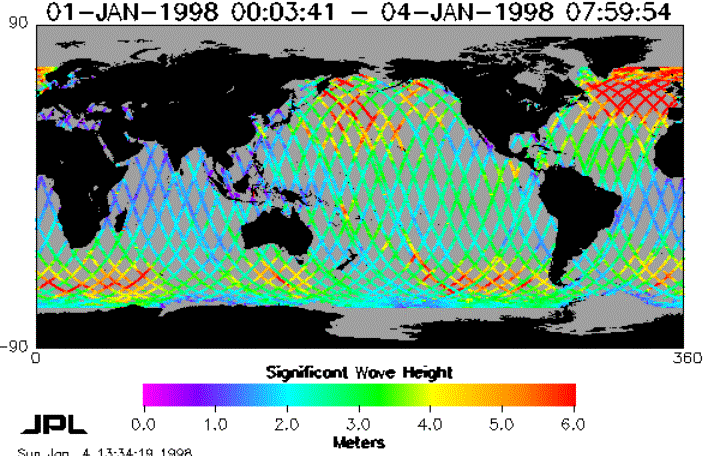 |
OC4331-Mesoscale
Oceanography
Final Project Summary
Topic Area
LCDR Denise M. Kruse, USN
LT Sean P. Memmen, USN
For the Caribbean Sea, studies using Geosat and TOPEX/POSEIDON were reviewed. The Caribbean Sea is a complex area divided up into several regions by bottom topography and islands. The main surface feature is the Caribbean Current flowing westward across the Sea from the Atlantic. There exists a quasi-permanent circulation in the Eastern part of the basin and a cyclonic eddy with seasonal variations in the southwestern portion of the Columbian Basin.
Raw data from the Geosat Altimeter must be manipulated extensively to remove errors due to many factors. In doing so, the mean currents and many quasi-permanent features are also removed reducing its usefulness. Sea surface height representing sea level variations associated with temporally varying quasi-geostrophic mesoscale features remains. Tracks of Geosat repeat every 17 days, and only three 17 day periods over the 1987-1988 time frame included sufficient data to be usable for study. These data showed a quasi-permanent cyclonic feature appearing several times around 12 N detected due to some change in intensity and/or location with time. Because the mean amplitude is removed, the feature must be stronger than shown in this study. Anticyclonic features last at least 51 days and travel westward at about 15 cm/sec indicating Caribbean Current interaction. No mesoscale features are seen in the eastern Caribbean Sea supporting the idea that circulations here are quasi-permanent and are removed with the mean amplitude during data processing.
In the second study of the Caribbean TOPEX/POSEIDON altimetry data spanning 3 years were processed and compared to ERS data, Geosat data, and an Atlantic Ocean model simulation. Due to limited altimeter data in the south because of topography interfearance, 14 deg North latitude, the latitude of max-observed sea level variability, was studied extensively. Ten distinct anticyclonic eddies and ten less distinct cyclonic eddies propagating westward and growing were observed corresponding well with the 6 over 2 years seen using Geosat data. Westward speeds of 11.7 cm/sec and an average scale of about 250km were seen which corresponds well with earlier studies. Comparison with a POP based model showed a similar pattern except the model had larger variability all over with the strongest in the Gulf of Mexico. T/P shows that eddies spin down before passing the Yucatan peninsula. ERS-1 data showed similar eddy positions, however eddy amplitudes were increased by a factor of two.
Finally, the third paper dealt with the detection of eddies in the Gulf of Alaska (GOA) with T/P. It used 222 passes between late 1992 through late 1998. The track is sampled between 45N and 60N where it is roughly parallel to the western coast of North America. The filter is optimized to detect eddies with amplitude >=10 cm, and diameters roughly 50 - 350 km. Both anticyclonic and cyclonic structures were examined. The distribution of eddies in space is similar for both anticyclonic and cyclonic eddies, with most occurring between 50N and the northern limits of the GOA. Few eddies of either sign were found south of 50N. Anticyclonic eddies are stronger and have a broader distribution of amplitudes (typically 5 - 30 cm) compared to cyclonic features which are more symmetrically distributed over 5 - 15 cm. The detection of weak (approx 15 cm) eddies is sensitive to the filter threshold, but detection of larger amplitude eddies is robust. The average amplitude of anticyclonic eddies increases following the 1993, 1994/95, and 1998 El Nino events. Eddy amplitude appears to vary with ENSO strength: the strongest eddies detected form in early 1998. These results support previous numerical studies of eddy development in the eastern GOA. (Meyers, 1999)
 |
References
Carton, J.A., and Y. Chao, 1999: "Caribbean Sea eddies inferred from TOPEX/POSEIDON altimetry and a 1/6 degree Atlantic Ocean model simulation" J. Geophys. Res., Vol. 104, 7743-7752.
Meyers, S.D., and S. Basu, 1999: "Eddies in the Eastern Gulf of Alaska from TOPEX/POSEIDON altimetry." J. Geophys. Res., Vol. 104, 13,333-13,343.
Nystuen, J.A., and C.A. Andrade, 1993: "Tracking mesoscale ocean features in the Caribbean Sea using Geosat altimetry." J. Geophys. Oceanogr., Vol. 98, 8389-8394.
Colorado Center for Astrodynamics Research, Global Near Real-Time Altimeter Data Viewer, http://www-ccar.colorado.edu/~realtime/global-real-time_ssh/
Colorado Center for Astrodynamics Research, TOPEX/Poseidon, ERS-1
& ERS-2 Global Mesoscale Historical Data Viewer, http://www-ccar.colorado.edu/~realtime/global-historical_ssh/
|
This is a government-maintained internet site. Please read the U.S. Navy web page disclaimer and the declaimer regarding external links. |
|